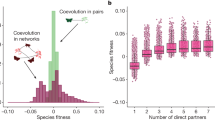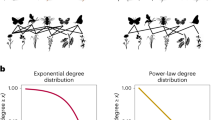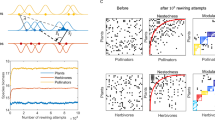Abstract
In theoretical ecology, simple stochastic models that satisfy two basic conditions about the distribution of niche values and feeding ranges have proved successful in reproducing the overall structural properties of real food webs, using species richness and connectance as the only input parameters1,2,3,4. Recently, more detailed models have incorporated higher levels of constraint in order to reproduce the actual links observed in real food webs5,6. Here, building on previous stochastic models of consumer–resource interactions between species1,2,3, we propose a highly parsimonious model that can reproduce the overall bipartite structure of cooperative partner–partner interactions, as exemplified by plant–animal mutualistic networks7. Our stochastic model of bipartite cooperation uses simple specialization and interaction rules, and only requires three empirical input parameters. We test the bipartite cooperation model on ten large pollination data sets that have been compiled in the literature, and find that it successfully replicates the degree distribution, nestedness and modularity of the empirical networks. These properties are regarded as key to understanding cooperation in mutualistic networks8,9,10. We also apply our model to an extensive data set of two classes of company engaged in joint production in the garment industry. Using the same metrics, we find that the network of manufacturer–contractor interactions exhibits similar structural patterns to plant–animal pollination networks. This surprising correspondence between ecological and organizational networks suggests that the simple rules of cooperation that generate bipartite networks may be generic, and could prove relevant in many different domains, ranging from biological systems to human society11,12,13,14.
This is a preview of subscription content, access via your institution
Access options
Subscribe to this journal
Receive 51 print issues and online access
$199.00 per year
only $3.90 per issue
Buy this article
- Purchase on Springer Link
- Instant access to full article PDF
Prices may be subject to local taxes which are calculated during checkout



Similar content being viewed by others
References
Williams, R. J. & Martinez, N. Simple rules yield complex food webs. Nature 404, 180–183 (2000)
Cattin, M. F., Bersier, L. F., Banasek-Richter, C., Baltensperger, R. & Gabriel, J. P. Phylogenetic constraints and adaptation explain food-web structure. Nature 427, 835–839 (2004)
Stouffer, D. B., Camacho, J., Guimerà, R., Ng, C. A. & Nunes Amaral, L. A. Quantitative patterns in the structure of model and empirical food webs. Ecology 86, 1301–1311 (2005)
Dunne, J. A., Williams, R. J., Martinez, N. D., Wood, R. A. & Erwin, D. H. Compilation and network analyses of Cambrian food webs. PLoS Biol. 6, 693–708 (2008)
Petchey, O. L., Beckerman, A. P., Riede, J. O. & Warren, P. H. Size, foraging, and food web structure. Proc. Natl Acad. Sci. USA 105, 4191–4196 (2008)
Allesina, S., Alonso, D. & Pascual, M. A general model for food web structure. Science 320, 658–661 (2008)
Bascompte, J. & Jordano, P. in Ecological Networks: Linking Structure to Dynamics in Food Webs (eds Pascual, M. & Dunne, J. A.) 143–159 (Oxford Univ. Press, 2006)
Jordano, P., Bascompte, J. & Olesen, J. M. Invariant properties in coevolutionary networks of plant-animal interactions. Ecol. Lett. 6, 69–81 (2003)
Bascompte, J., Jordano, P., Melián, C. J. & Olesen, J. M. The nested assembly of plant–animal mutualistic networks. Proc. Natl Acad. Sci. USA 100, 9383–9387 (2003)
Olesen, J. M., Bascompte, J., Dupont, Y. L. & Jordano, P. The modularity of pollination networks. Proc. Natl Acad. Sci. USA 104, 19891–19896 (2007)
Sampson, R. J., Raudenbush, S. W. & Earls, F. Neighborhoods and violent crime: A multilevel study of collective efficacy. Science 277, 918–924 (1997)
Ostrom, E., Burger, J., Field, C. B., Norgaard, R. B. & Policansky, D. Revisiting the commons: Local lessons, global challenges. Science 284, 278–282 (1999)
Hammerstein, P. (ed.) Genetic and Cultural Evolution of Cooperation (MIT Press, 2003)
Ohtsuki, H., Hauert, C., Lieberman, E. & Nowak, M. A. A simple rule for the evolution of cooperation on graphs and social networks. Nature 441, 502–505 (2006)
Bronstein, J. L. The exploitation of mutualisms. Ecol. Lett. 4, 277–287 (2001)
Waser, N. M., Chittka, L., Price, M. V., Williams, N. M. & Ollerton, J. Generalization in pollination systems, and why it matters. Ecology 77, 1043–1060 (1996)
Noë, R. & Hammerstein, P. Biological markets: supply and demand determine the effect of partner choice in cooperation, mutualism and mating. Behav. Ecol. Sociobiol. 35, 1–11 (1994)
Olesen, J. M. & Jordano, P. Geographic patterns in plant–pollinator mutualistic networks. Ecology 83, 2416–2424 (2002)
Guimarães, P. R., Rico-Gray, V., Furtado dos Reis, S. & Thompson, J. N. Asymmetries in specialization in ant–plant mutualistic networks. Proc. R. Soc. Lond. B 273, 2041–2047 (2006)
Rezende, E. L., Lavabre, J. E., Guimarães, P. R., Jordano, P. & Bascompte, J. Non-random coextinctions in phylogenetically structured mutualistic networks. Nature 448, 925–928 (2007)
Santamaría, L. & Rodríguez-Gironés, A. Linkage rules for plant-pollinator networks: Trait complementarity or exploitation barriers? PLoS Biol. 5, 354–362 (2007)
Guimarães, P. R. et al. Building-up mechanisms determining the topology of mutualistic networks. J. Theor. Biol. 249, 181–189 (2007)
Uzzi, B. The sources and consequences of embeddedness for the economic performance of organizations: the network effect. Am. Sociol. Rev. 61, 674–698 (1996)
Carroll, G. R. & Hannan, M. T. The Demography of Corporations and Industries (Princeton Univ. Press, 2004)
Podolny, J. M. Status Signals: A Sociological Study of Market Competition (Princeton Univ. Press, 2005)
Amaral, L. A. N., Scala, A., Barthélémy, M. & Stanley, H. E. Classes of small-world networks. Proc. Natl Acad. Sci. USA 97, 11149–11152 (2000)
Moody, J. & White, D. R. Structural cohesion and embeddedness: A hierarchical concept of social groups. Am. Sociol. Rev. 68, 103–127 (2003)
Rodríguez-Gironés, M. A. & Santamaría, L. A new algorithm to calculate the nestedness temperature of presence–absence matrices. J. Biogeography 33, 924–935 (2006)
Girvan, M. & Newman, M. E. J. Community structure in social and biological networks. Proc. Natl Acad. Sci. USA 99, 7821–7826 (2002)
Guimerà, R. & Nunes Amaral, L. A. Functional cartography of complex metabolic networks. Nature 433, 895–900 (2005)
Acknowledgements
We thank J. Dunne, R. Guimerà, J. Kertész, M. Sales-Pardo, D. Stouffer and R. Williams for comments and suggestions. F.R.-T. acknowledges funding from the European Commission under the FP6 NEST Pathfinder Initiative ‘Tackling Complexity in Science’ (MMCOMNET project, contract no. 012999). S.S. held a Doctoral Research Studentship funded by MMCOMNET and CONACYT, and currently is supported by a Postdoctoral Fellowship at the Oxford University Corporate Reputation Centre in conjunction with the CABDyN Complexity Centre.
Author Contributions B.U. provided the NYGI data; F.R.-T. designed the research; S.S., F.R.-T. and B.U. analysed the data; S.S. ran the simulations; S.S. and F.R.-T. wrote the paper.
Author information
Authors and Affiliations
Corresponding author
Supplementary information
Supplementary Information
This file contains Supplementary Text 1 (Comparison of mutualistic models), Supplementary Tables S1-S5, Supplementary Text 2 (Pollination-network datasets), Supplementary Text 3 (The New York garment industry network), Supplementary Figures S1-S3 and Supplementary References. (PDF 935 kb)
Rights and permissions
About this article
Cite this article
Saavedra, S., Reed-Tsochas, F. & Uzzi, B. A simple model of bipartite cooperation for ecological and organizational networks. Nature 457, 463–466 (2009). https://doi.org/10.1038/nature07532
Received:
Accepted:
Published:
Issue Date:
DOI: https://doi.org/10.1038/nature07532
This article is cited by
-
The role of intra-guild indirect interactions in assembling plant-pollinator networks
Nature Communications (2023)
-
Detecting and generating overlapping nested communities
Applied Network Science (2023)
-
Productive Ecosystems and the arrow of development
Nature Communications (2021)
-
Deciphering functional redundancy in the human microbiome
Nature Communications (2020)
-
Mutualistic networks emerging from adaptive niche-based interactions
Nature Communications (2020)
Comments
By submitting a comment you agree to abide by our Terms and Community Guidelines. If you find something abusive or that does not comply with our terms or guidelines please flag it as inappropriate.



